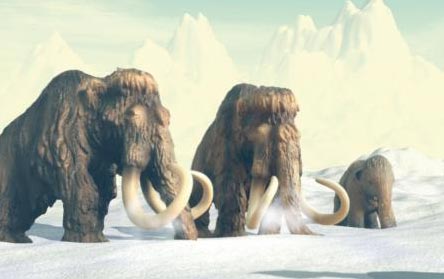Woolly Mammoth Carcase from Siberia Holds Evolutionary Clues
The discovery of a partial female Woolly Mammoth carcase by scientists from the North Eastern Federal University, the Research Institute of Applied Ecology and the Russian Geographical Society may prove to be the best preserved found to date. The carcase, when examined provided samples of blood and the tissue is still pink and “flesh-like” in parts. This fossil find in the Lyakhovsky islands of the Novosibirsk archipelago in the Eastern Siberia sea moves the possibility of being able to clone a mammoth one step nearer, but cloning still remains a long way off.
Woolly Mammoth Carcase
Although a significant proportion of the creature’s body had been lost and there were signs of scavengers having attacked the corpse, the scientists were able to remove the head, the torso and one of the hind legs. An assessment of the molars indicate that this Woolly Mammoth was between 50-60 years of age when she died.
Semyon Grigoriev, the leader of the field team working in the extreme conditions, commented:
“The fragments of muscle tissues, which we’ve found out of the body, have a natural red colour of fresh meat. The reason for such preservation is that the lower part of the body was underlying in pure ice, and the upper part was found in the middle of tundra. We found a trunk separately from the body, which is the worst-preserved part.”
Evidence of Blood
When the corpse was probed with a pick, some reddish liquid, originally described as blood began to ooze from it, a phenomenon not recorded before as far as we know and it is remarkable how well preserved some of the soft tissues may be on this particular fossil specimen. The researchers were able to collect samples of this blood-like liquid. It looks very dark and since the temperature at the time of the excavation was between -7 to -10 Celsius, it is remarkable that the blood would still be liquid at these temperatures.
The scientists have speculated that the blood may have some anti-freezing properties, perhaps an adaptation to living in extreme climates. Alternatively, the flowing blood could be explained by the presence of bacteria with cryo-protective properties in the samples. The carcase may have been contaminated and the blood has remained liquid in part due to the presence of these contaminants.
The blood, or indeed the liquid containing elements of the constituents that make up Woolly Mammoth blood, which was found in ice cavities below where the belly would have been, will help scientists to understand more about the unique properties of cold-adapted mammals.
The Russian team are hoping that their discovery will further the research of University of Manitoba Professor Kevin Campbell, who has theorised that the haemoglobin of Woolly Mammoths had special properties that made it very efficient at delivering oxygen to tissues even at extremely low temperatures. Recently, a phial of Mammoth blood has gone on display in a Canadian museum, to read more about this and the work of Professor Campbell: Woolly Mammoth Blood Goes on Display.
Blood and Tissue Samples Sent for Analysis
The blood and tissue samples have been sent to Yakutsk so that they can be screened for any potential harmful bacteria and then it is hoped that other international Mammoth experts will be able to join the Russian team as they study this specimen.
Although the scientists had to work in very harsh conditions, being able to find carcases in the cold weather is very important as it aids the preservation of specimens.
Semyon Grigoriev explained that it was important to find Mammoths in cold conditions as the specimen would be thawed and subsequently damaged in the summer. Such finds would not be as valuable to scientists as they attempt to plot the Woolly Mammoth genome with the long-term aim of cloning one of these Ice Age giants in the future.
Professor Campbell, has had the opportunity to study some of the photographs taken by the research team as the carcase was carefully excavated. He noted that the soft tissues looked particularly well-preserved and he stated:
“The animal’s muscle tissue is pink rather than the brown colour it turns when the proteins are damaged and oxidised, indicating that it is “extremely well preserved. The blood also appears reddish, it may be possible to look at any preserved haemoglobin.”
Trying to Identify Undamaged Cells
One of the objectives of the researchers is to identify intact, undamaged cells in the specimen. Although fragments of genetic material have been recovered from some specimens, if an intact cell could be found then it would help to increase the possibility of being able to clone a living Mammoth. An intact cell could be used to generate more cells and this would make cloning much easier than by trying to use fragments of DNA and piece data together from the DNA alone.
Does this Mean that Cloning a Woolly Mammoth is Closer?
Picture credit: Everything Dinosaur
The picture above shows a Woolly Mammoth family, for models and replicas of Woolly Mammoths and other Ice Age creatures: Papo “Les Dinosaures” Models and Replicas.
However, many observers doubt that even a carcass this well preserved could yield any intact cellular material. Enzymes in bacteria that normally live inside animals such as mammals rapidly break down cells and DNA shortly after death occurs. To have any chance of finding such material the carcase would have had to be frozen solid very quickly, just a short time after death. This said, the specimen does offer the intriguing possibility that our ability to clone an extinct animal from genetic material recovered from a fossil may be one step closer.
To read another recent article on the discovery of a Siberian Woolly Mammoth fossil: Russian Scientists Study Mammoth.






Leave A Comment